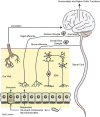Bacterial Signaling to the Nervous System through Toxins and Metabolites
- PMID: 28065740
- PMCID: PMC5325782
- DOI: 10.1016/j.jmb.2016.12.023
Bacterial Signaling to the Nervous System through Toxins and Metabolites
Abstract
Mammalian hosts interface intimately with commensal and pathogenic bacteria. It is increasingly clear that molecular interactions between the nervous system and microbes contribute to health and disease. Both commensal and pathogenic bacteria are capable of producing molecules that act on neurons and affect essential aspects of host physiology. Here we highlight several classes of physiologically important molecular interactions that occur between bacteria and the nervous system. First, clostridial neurotoxins block neurotransmission to or from neurons by targeting the SNARE complex, causing the characteristic paralyses of botulism and tetanus during bacterial infection. Second, peripheral sensory neurons-olfactory chemosensory neurons and nociceptor sensory neurons-detect bacterial toxins, formyl peptides, and lipopolysaccharides through distinct molecular mechanisms to elicit smell and pain. Bacteria also damage the central nervous system through toxins that target the brain during infection. Finally, the gut microbiota produces molecules that act on enteric neurons to influence gastrointestinal motility, and metabolites that stimulate the "gut-brain axis" to alter neural circuits, autonomic function, and higher-order brain function and behavior. Furthering the mechanistic and molecular understanding of how bacteria affect the nervous system may uncover potential strategies for modulating neural function and treating neurological diseases.
Keywords: bacteria; gut–brain axis; microbiota; neurons; toxins.
Copyright © 2017 Elsevier Ltd. All rights reserved.
Figures



References
Publication types
MeSH terms
Substances
Grants and funding
LinkOut - more resources
Full Text Sources
Other Literature Sources

